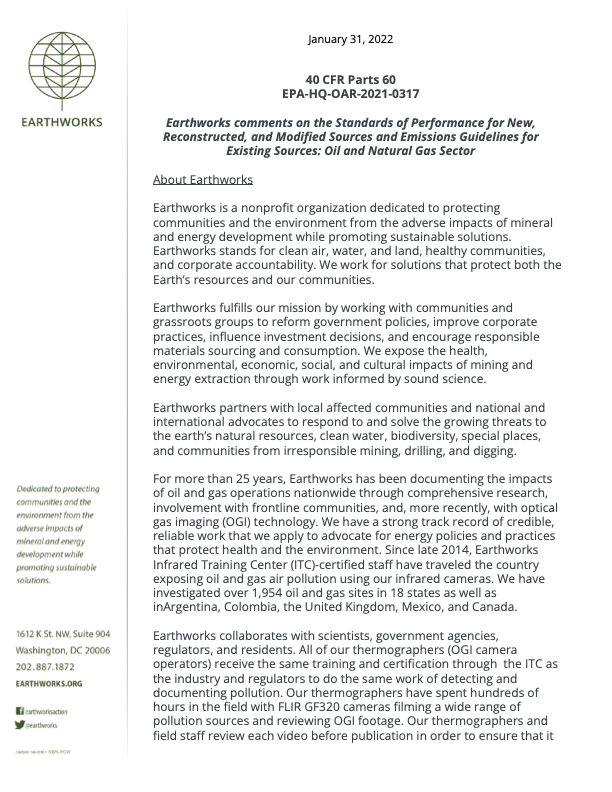From the Comments
Until we manage the decline of fossil fuels and transition to a cleaner, more equitable energy system, the EPA must:
- Strengthen monitoring requirements to require frequent leak detection and repair inspections at all wells. The EPA has recognized in its proposal that a “low production” exemption is not appropriate. However, under the current proposal, operators that calculate lower potential emissions (less than 3 tons per year of methane) could avoid all monitoring after just one initial inspection. Rigorous monitoring requirements that reduce emissions by 80 to 90 percent (consistent with the EPA’s estimates for quarterly to monthly inspections) must apply comprehensively across all facilities. This includes wells with a calculated potential to emit below 3 tons per year. These calculations are based on emission factors that very likely underrepresent the true extent of fugitives originating from these wells, and do not account for equipment failures or malfunctions that can lead to super-emitting events. Thus, the EPA should not provide special and more lenient requirements for these wells, but should mandate regular monitoring at all wells, regardless of their calculated potential to emit.
- Eliminate routine flaring. The EPA’s proposal does not go far enough to address pollution from flaring, and must prohibit the practice of routine flaring at oil and gas sites. When companies rush to extract oil, some forgo investments necessary to capture and sell gas and instead burn it as a waste product, emitting a host of climate and health-harming pollutants. Flaring is a wasteful practice and a large source of methane, carbon dioxide, nitrogen oxides, VOCs, and HAPs. Capturing natural gas that would otherwise be vented or flared reduces significant amounts of pollution and even generates revenue for operators. The EPA must eliminate flaring except in emergency situations and must also ensure that flares are operating properly and are frequently inspected to ensure they are lit and operating at maximum efficiency.
- Require monitoring and plugging of abandoned wells that are leaking methane. According to the Reuters investigation, which conducted a comprehensive review of all available data in 2020, orphaned and abandoned wells in the United States were collectively responsible for emitting 281,000 tons of methane into the atmosphere in 2018. While orphaned wells no longer have an identifiable owner, abandoned wells are typically defined as an unproductive well with a known owner/operator. EPA should require twice-a-year monitoring at idle and unplugged wells, while also including a requirement for companies to submit comprehensive well closure plans in order to properly cap wells at their end of life.
These important gaps on critical issues must be addressed to ensure public health is prioritized, frontline communities are protected, and oil and gas companies are held accountable. Where the EPA has proposed protective standards, such as rules eliminating the use of intentionally-polluting pneumatic controllers and requiring a transition to zero-emitting solutions, it is critical that the Agency follows through and finalizes strong rules. Methane pollution from the oil and gas sector is accelerating the pace of climate change and harming the health of our families and communities—and the problem is only getting worse. Oil and gas infrastructure is also next to or nearby some of our most treasured natural and cultural sites on public lands, areas that are warming at nearly twice the rate of the rest of the country and experiencing dramatic impacts from a changing climate. There is no time to waste, and we cannot miss out on this opportunity to create the strongest standards possible to limit pollution from the oil and gas industry.

